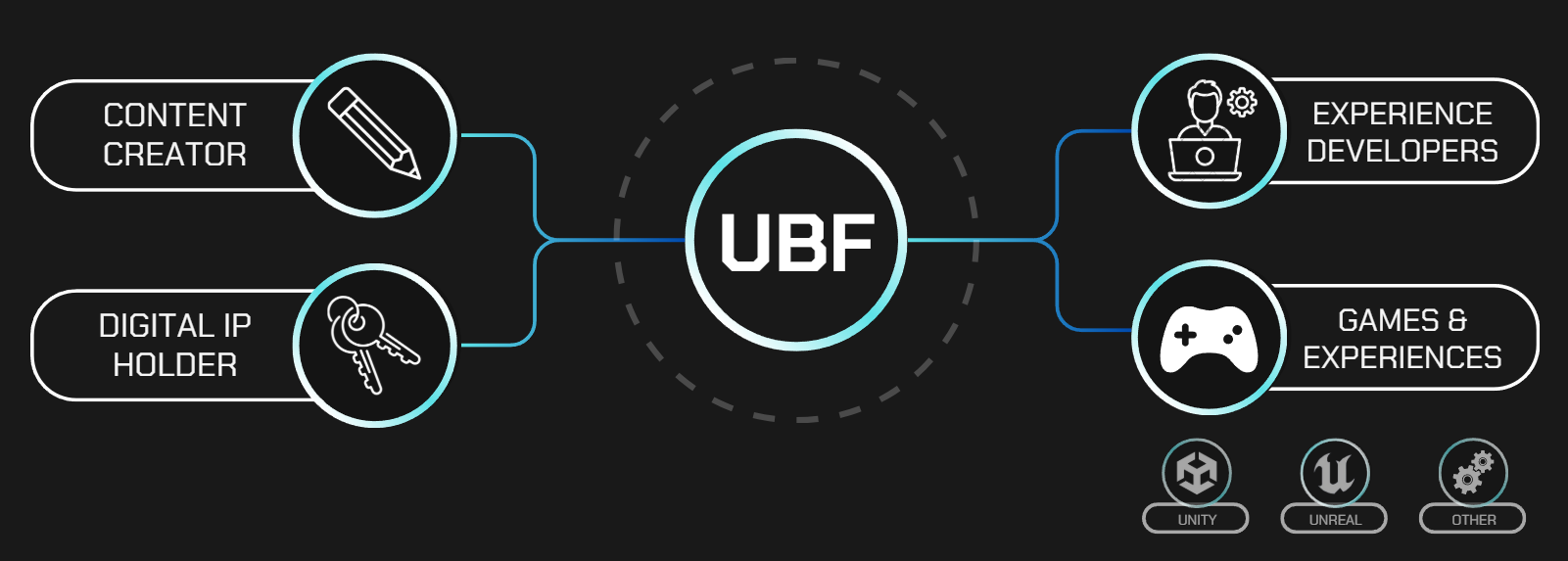What is UBF?
The Universal Blueprint Framework (UBF) is a comprehensive standard and framework that catalyzes and ultimately enables true interoperability in digital applications and interactive experiences. UBF has been designed to occupy a unique position in the industry—situating itself squarely between content creators/IP holders and experienced developers—offering unprecedented value for both parties.
Why Interoperability Matters
A lack of interoperability creates a host of problems for both IP holders and content creators, as well as experienced developers and the applications they build.Experience Developer’s Perspective
Imagine you’re working on a new game project partnered with a major IP holder. This IP partnership means your title features a roster of beloved characters—each with unique accessories and items to equip.- Initial Integration You’ll spend significant development time inserting these characters, accessories, and items exactly as the IP holder dictates—time you could have devoted to your game’s core features. Every step demands back-and-forth reviews to ensure you’ve met brand standards and quality requirements.
- Ongoing Maintenance Six months after your game’s launch, the IP holder decides to tweak some of their assets. Even though your actual game hasn’t changed, you must dive back into your codebase to apply these tweaks, receive re-approvals, and publish a patch—just to stay consistent with the updated IP. If you have multiple IP partnerships, the workload multiplies exponentially, turning into a never-ending cycle of patches and builds.
IP Holder’s (Content Creator’s) Perspective
Meanwhile, IP holders face their own logistical challenges:- Distributed Collaboration You might have hundreds of experiences and media outlets using your content. Each integration requires coordination, approval, and oversight—from checking that characters are functioning as designed to ensuring color schemes are correct.
- Version Control Chaos When you make even minor changes to your IP, you have no direct way to roll out those updates yourself. Instead, you must contact each developer—potentially hundreds—to request and validate the change. Tracking who’s on version “X,” “Y,” or “Z” quickly spirals into a nightmare, and maintaining brand consistency becomes nearly impossible.
How UBF Enables Interoperability
Externalized Instructions
To solve the challenges described above, UBF takes a different approach to those developments in conventional and traditional game development. UBF empowers creators to externalise all the instructions an asset or feature needs—removing them entirely from any single application’s domain. These instructions, known as blueprints within the context of UBF, can describe everything from how a character is composed and rendered on-screen to how it behaves in-game.Engine Agnostic
Because blueprints are engine agnostic, content creators don’t have to concern themselves with the differences between Unity, Unreal, or another engine entirely. They can create a single blueprint, and that same blueprint can be injected into any UBF-supported environment with no additional work. This massively reduces the overhead for IP holders wanting their characters or items to appear across a range of experiences.Dynamic Content Injection
Perhaps the most powerful advantage of this model is that changes happen in real time, without forcing developers to patch their applications or end users to download large updates. When IP holders or content creators decide to tweak an asset’s look or functionality, they only need to update the relevant blueprint. Those modifications then automatically propagate to all experiences referencing that blueprint—no developer intervention is required. The end result—- For Developers
- Can focus on building their core experiences, free from intrusive IP related patch cycles.
- Offer richer and dynamic content to your users without the need to update your project.
- For Content creators
- Create assets once and reuse them across unlimited experiences on a multitude of engines.
- Update assets on the fly without the need to coordinate with leveraging partners.
- Maintain control over your IP - both for the present and the future.

